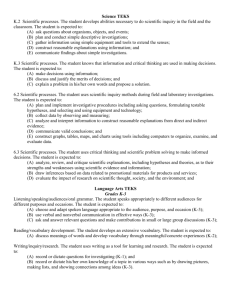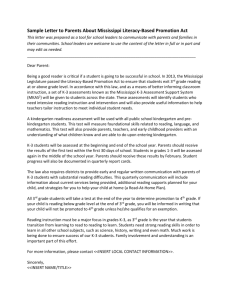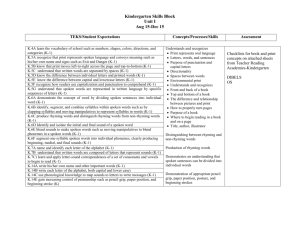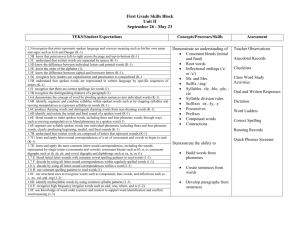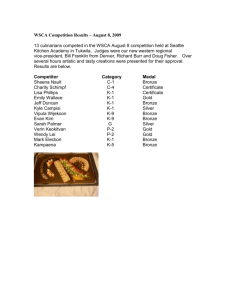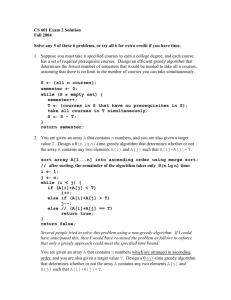Kindergarten TEKS with District Specificities
advertisement
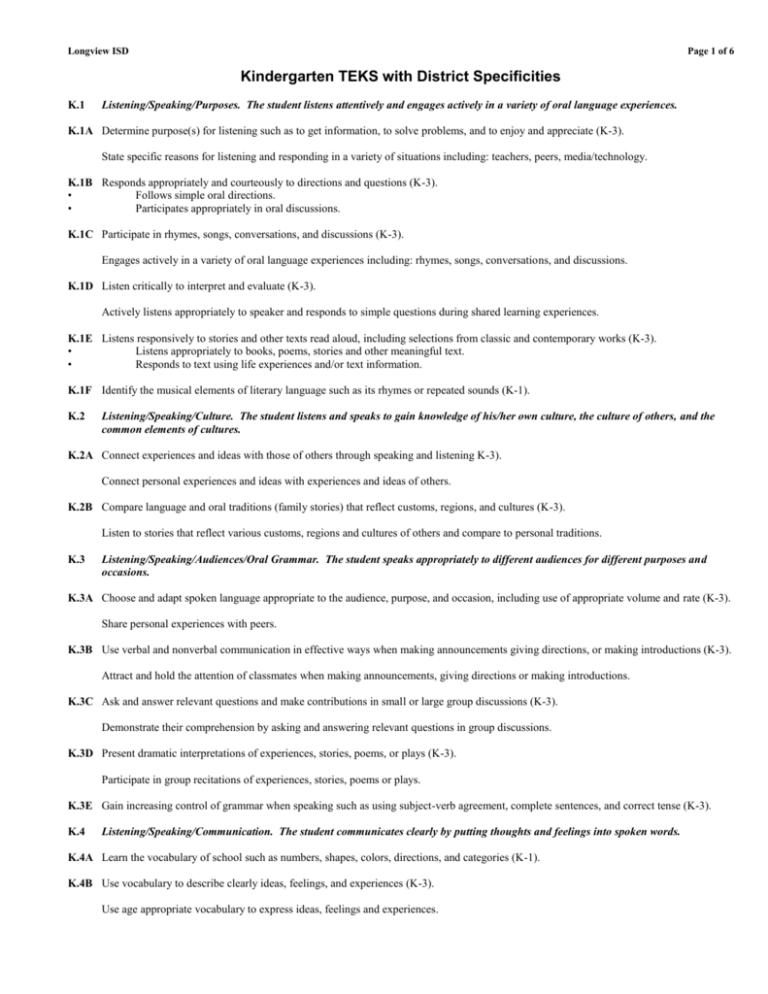
Longview ISD Page 1 of 6 Kindergarten TEKS with District Specificities K.1 Listening/Speaking/Purposes. The student listens attentively and engages actively in a variety of oral language experiences. K.1A Determine purpose(s) for listening such as to get information, to solve problems, and to enjoy and appreciate (K-3). State specific reasons for listening and responding in a variety of situations including: teachers, peers, media/technology. K.1B Responds appropriately and courteously to directions and questions (K-3). • Follows simple oral directions. • Participates appropriately in oral discussions. K.1C Participate in rhymes, songs, conversations, and discussions (K-3). Engages actively in a variety of oral language experiences including: rhymes, songs, conversations, and discussions. K.1D Listen critically to interpret and evaluate (K-3). Actively listens appropriately to speaker and responds to simple questions during shared learning experiences. K.1E Listens responsively to stories and other texts read aloud, including selections from classic and contemporary works (K-3). • Listens appropriately to books, poems, stories and other meaningful text. • Responds to text using life experiences and/or text information. K.1F Identify the musical elements of literary language such as its rhymes or repeated sounds (K-1). K.2 Listening/Speaking/Culture. The student listens and speaks to gain knowledge of his/her own culture, the culture of others, and the common elements of cultures. K.2A Connect experiences and ideas with those of others through speaking and listening K-3). Connect personal experiences and ideas with experiences and ideas of others. K.2B Compare language and oral traditions (family stories) that reflect customs, regions, and cultures (K-3). Listen to stories that reflect various customs, regions and cultures of others and compare to personal traditions. K.3 Listening/Speaking/Audiences/Oral Grammar. The student speaks appropriately to different audiences for different purposes and occasions. K.3A Choose and adapt spoken language appropriate to the audience, purpose, and occasion, including use of appropriate volume and rate (K-3). Share personal experiences with peers. K.3B Use verbal and nonverbal communication in effective ways when making announcements giving directions, or making introductions (K-3). Attract and hold the attention of classmates when making announcements, giving directions or making introductions. K.3C Ask and answer relevant questions and make contributions in small or large group discussions (K-3). Demonstrate their comprehension by asking and answering relevant questions in group discussions. K.3D Present dramatic interpretations of experiences, stories, poems, or plays (K-3). Participate in group recitations of experiences, stories, poems or plays. K.3E Gain increasing control of grammar when speaking such as using subject-verb agreement, complete sentences, and correct tense (K-3). K.4 Listening/Speaking/Communication. The student communicates clearly by putting thoughts and feelings into spoken words. K.4A Learn the vocabulary of school such as numbers, shapes, colors, directions, and categories (K-1). K.4B Use vocabulary to describe clearly ideas, feelings, and experiences (K-3). Use age appropriate vocabulary to express ideas, feelings and experiences. Longview ISD K.4C Page 2 of 6 Clarify and support spoken messages using appropriate props such as objects, pictures, or charts (K-3). Relate personal experiences or ideas using pictures or objects. K.4D Retell a spoken message by summarizing or clarifying (K-3). Orally summarize a spoken message using or including main idea or important details. K.5 Reading/Print Awareness. The student demonstrates knowledge of concepts of print. K.5A • • • Recognize that print represents spoken language and conveys meaning such as his/her own name and signs such as Exit and Danger (K1). Recognizes environmental print, labels, signs and his/her name. Utilizes word wall. Participates in shared and interactive writing. K.5B Know that print moves left-to-right across the page and top-to-bottom (K-1). Demonstrate directionality including left to right and top to bottom in printed text. K.5C • • Understand that written words are separated by spaces (K-1). Identifies the concept of spacing between words through shared reading. Demonstrates one to one matching during guided reading. K.5D Know the difference between individual letters and printed words (K-1). Frame letters and words in continuous text (shared reading, guided reading.) K.5E Know the difference between capital and lowercase letters (K-1). Identify the difference between capital and lowercase letters in big books and other text. K.5F • • Recognize how readers use capitalization and punctuation to comprehend (K-1). Recognize that a capital letter indicates the beginning of a new thought by the author. Recognize that an ending punctuation mark indicates the end of the author’s thought. K.5G Understand that spoken words are represented in written language by specific sequences of letters (K-1). Recognizes high frequency words in print. K.5H • • Recognize that different parts of a book such as cover, title page, and table of contents offer information (K-1). Identifies the title, author and illustrator on the cover and title page. Recognizes table of contents. K.6 Reading/Phonological Awareness. The student orally demonstrates phonological awareness (an understanding that spoken language is composed of sequences of sounds) K.6A Demonstrate the concept of word by dividing spoken sentences into individual words (K-1) Segment sentences into words. K.6B K.6C Identify, segment, and combine syllables within spoken words such as clapping syllables and moving manipulatives to represent syllables in words (K-1). Produce rhyming words and distinguish rhyming words from non-rhyming words (K-1). Identify rhyming words through poems, nursery rhymes and songs. K.6D • • Identify and isolate the initial and final sound of spoken word (K-1). Identify and isolate onset and rime in spoken words. Identify and isolate initial and ending sounds of spoken words. K.6E Blend sounds to make spoken words such as moving manipulatives to blend phonemes in a spoken word (K). Including blending onset and rime in spoken words (ex: /c/ + /at/ = cat; /b/ + /at/ = bat) Blend phonemes orally to produce spoken words (up to and including 3 sounds.) Longview ISD K.6F Page 3 of 6 Segment one-syllable spoken words into individual phonemes, clearly producing beginning, medial, and final sounds (K-1). Including: • Segment onset and rime in spoken words (ex: cat = /c/ + /at/; bat = /b/ + /at/) • Segment individual phonemes in spoken words (ex: cat = /c/ + /a/ + /t/ Segment spoken words into phonemes (up to and including 3 sounds.) K.7 Reading/Letter-Sound Relationships. The student uses letter-sound knowledge to decode written language. K.7A • • Name and identify each letter of the alphabet (K-1). Recognize the names of the letters in sequence and in random order (upper and lowercase.) Matches capital to lowercase letters. K.7B Understand that written words are composed of letters that represent sounds (K-1). Associate letters with sounds in written words during the reading of continuous text. K.7C Learn and apply letter-sound correspondences of a set of consonants and vowels to begin to read (K-1). Use letter/sound correspondence to decode words in continuous text. K.8 Reading/Vocabulary Development. The student develops an extensive vocabulary. K.8A • • Discuss meanings of words and develop vocabulary through meaningful/concrete experiences (K-2). Learning to follow directions and following the language of school. Take part in language activities that extend their vocabulary and conceptual knowledge. K.8B • Develop vocabulary by listening to and discussing both familiar and conceptually challenging selections read aloud (K-3). Hear new vocabulary as presented in stories and informational text. K.8C Identify words that name persons, places, or things and words that name actions (K-1). Locate and recognize words that names, persons, places or things (nouns and verbs) through continuous text and word walls. K.9 Reading/Comprehension. The student uses a variety of strategies to comprehend selections read aloud. K.9A • • Use prior knowledge to anticipate meaning and make sense of texts (K-3). Connect personal experiences and ideas with information and ideas presented in print. Predict outcomes based on personal experiences and content. K.9B Establish purposes for reading or listening such as to be informed, to follow directions, and to be entertained (K-3). K.9C • • Retell or act out the order of important events in stories (K-3). Listen actively in order to retell stories. Sequence important events in stories using props, pictures and story maps and other graphic organizers. No TEKS in K K.10 Possible Alignment Add: Draw and discuss visual images based on text descriptions (1-3). Reading/Literary Responses. The student responds to various texts. K.10A Listen to stories being read aloud (K-1). K.10B Participate actively (react, speculate, join in, read along) when predictable and patterned selections are read aloud (K-1). • • • Participate in shared reading of predictable and patterned text by: Joining in Reading along Making predictions K.10C Respond through talk, movement, music, art, drama, and writing to a variety of stories and poems in ways that reflect understanding and interpretation (K-1). Interacts with teacher, peers and text during classroom discussions and activities (role playing/drama, art, music, movement.) Longview ISD Page 4 of 6 K.10D • • Describe how illustrations contribute to the text (K-1). Take picture walks to establish meaning of text. Use picture clues as a reading strategy. K.11 Reading/Text Structures/Literary Concepts. The student recognizes characteristics of various types of texts. K.11A • • Distinguish different forms of texts such as lists, newsletters, and signs and the functions they serve (K-3). Identify the unique characteristics of articles, signs and other texts. Identify purpose of different kinds of text. K.11B Understand simple story structure (K-1). • • • • • Identify elements of a story including: Characters Setting Problem Resolution Conclusion K.11C Distinguish fiction from nonfiction, including fact and fantasy (K-3). • • Recognize elements of fiction including: Fantasy Realistic fiction • • Recognize elements of non-fiction including: Informational Text Factual Stories K.11D Understand literary forms by recognizing and distinguishing among such types of text as stories, poems, and information books (K-2). • • • Recognizes characteristics of various types of texts: Stories (e.g., titles, author, illustrator) Poems (patterns of rhythm and/or rhyme) Information books (titles, author, illustrator, labels, captions, etc.) K.11E Understand literary terms by distinguishing between the roles of the author and illustrator (K-1). • • Distinguish between roles of the author and the illustrator. Recognizes the author writes the words of the story. Recognizes the illustrator draws the pictures. K.12 Reading/Inquiry/Research. The student generates questions and conducts research about topics introduced through selections read aloud and from a variety of other sources. K.12A Identify relevant questions for inquiry (K-3). Asks and answers relevant questions for personal clarification and extension of ideas in group discussions. K.12B Use pictures, print, and people to gather information and answer questions (K-1). Use pictures, print, and informal interviews to gather information in response to self-, peer-, and teacher generated questions. K.12C Draw conclusions from information gathered (K-3). • • • • Demonstrate comprehension through extensive practice including each of the following: Inferences Cause and Effect Make predictions Draw and support conclusions Longview ISD K.12D Locate important areas of the library/media center (K-1). • • • • Locate: Check-out desk Reference books Fiction books Non-fiction books Page 5 of 6 K.13 Reading/Culture. The student reads or listens to increase knowledge of his/her own culture, the culture of others, and the common elements of cultures. K.13A Connect his/her own experiences with the life experiences, language, customs, and culture of others (K-3). • • Make cultural connections by: Discussing his or her customs and culture and those of others after listening to family stories and stories from children’s books and Connecting those personal experiences with the life experiences, language, customs, and culture of others K.13B Compare experiences of characters across cultures (K-3). Read and listen to literatures from different cultures. K.14 Writing/Spelling/Penmanship. The student develops the foundations of writing. K.14A Write his/her own name and other important words (K-1). • • • Write with increasing fluency and automaticity including: Prints his or her own name with appropriate placement of capital and lower-case letters Print family member names and/or other words meaningful to individual students Print some high frequency words K.14B Write each letter of the alphabet, both capital and lowercase (K). K.14C Use phonological knowledge to map sounds to letters to write messages (K-1). • • • Link sounds to letters to write messages using: Letter-sound correspondence Spelling patterns developmental spelling K.14D Write messages that move left-to-right and top-to-bottom on the page (K-1). • • • K.14E Demonstrate proper directionality through: Short responses to questions Captions for pictures/drawings Writing products Gain increasing control of penmanship such as pencil grip, paper position, and beginning stroke (K). K.15 Writing/Composition. The student composes original texts. K.15A Dictate messages such as news and stories for others to write (K-1). • • • Dictate messages through: Morning messages Reading responses Shared writing K.15B Write labels, notes, and captions for illustrations, possessions, charts, centers (K-1). K.15C Write to record ideas and reflections (K-3). • • • • Record ideas and reflections through: Journal writing Reading responses Listening responses Interactive writing Longview ISD K.15D Generate ideas before writing on self-selected topics (K-1). • • • Participate in generating ideas before writing on self-selected topics in whole group through: Interactive writing Shared writing and in independent writing K.15E Generate ideas before writing on assigned tasks (K-1). • • • Participate in generating ideas before writing on assigned topics in whole group through: Interactive writing Shared writing and in independent writing K.15F Use available technology to compose text (K-3). K.16 Writing/Inquiry/Research. The student uses writing as a tool for learning and research. K.16A Record or dictate questions for investigating (K-1). Page 6 of 6 Dictate relevant questions on a topic he/she would like to investigate and on topics introduced in oral reading selections K.16B Record or dictate his/her own knowledge of a topic in various ways such as by drawing pictures, making lists, and showing connections among ideas (K-3).
